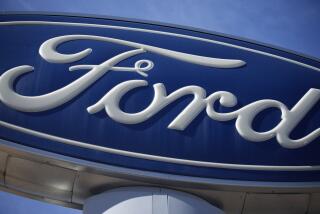America’s Big-Bodied Autos Coming to End of the Road
- Share via
DETROIT — The big, heavy rear-wheel-drive cars that for decades have been symbols of American industrial might are coming to the end of the road.
The last Buick Roadmaster, Cadillac Fleetwood, Chevrolet Caprice and Impala SS models will roll out of a General Motors Corp. plant in Arlington, Tex., next year, victims of changing automotive tastes, GM said Tuesday.
The move represents the end of an era.
“These are the big, heavy-bodied cars that tamed the frontier of the highway,” said Michael Marsden, dean of arts and sciences at Northern Michigan University and a scholar of the automobile in American culture.
The Roadmaster, Fleetwood and Caprice are direct descendants of Detroit’s iron of the ‘50s and ‘60s, when tail fins, acres of chrome and massive V-8 engines symbolized the strength of the nation and its car makers. Buick used terms such as “carnivorous” to describe the vertical bar grille of its port-holed Roadmasters of that era.
But most of today’s buyers are not looking for two-ton road locomotives with soft suspensions and steering that isolate drivers from the road.
Chrysler Corp. stopped making its “boats” in the 1980s, and three models from Ford Motor Co. are the only other comparable vehicles on the market.
GM is converting the Arlington plant to truck production because that is where the money is. Its sales of light trucks have doubled since 1975.
Caprice and Fleetwood have been favorites of police departments, limousine companies, funeral homes and taxicab fleets. “But there’s no retail demand for these cars,” said auto analyst Christopher Cedergren in Thousand Oaks.
Last year, GM sold only about 157,000 of the large cars built at Arlington. At the same time, it was unable to meet demand for its full-size pickup trucks and sport-utility vehicles, of which it sold about 900,000.
Ironically, the big cars were among the first models GM “downsized” in the 1970s in response to fuel-economy regulations, the oil crisis and the onslaught of small Japanese imports.
“When they were launched for the ’77 model year, dealers actually complained that they were too small,” Cedergren said.
GM said buyers will readily switch to other large cars in the GM lineup, front-wheel drive Cadillacs, Buicks and Oldsmobiles.
But many police and taxi customers will probably turn to Ford’s rear-drive Lincoln Town Car and Crown Victoria.
That is because heavy, rear-wheel drive cars tend to hold up better to the abuse that police cars receive, and auto makers have had little success making front-drive cars that can be easily converted to limousines.






